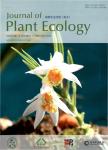Genetic variation in the reduction of attractive floral traits of an annual tarweed in response to drought and apical damage
作者机构:Laboratorio de Ecología EvolutivaLIDFacultad de Ciencias y FilosofíaUniversidad Peruana Cayetano HerediaLimaPerú Departamento de EcologíaP.Universidad Católica de ChileSantiagoChile Departamento de BiologíaUniversidad de La SerenaLa SerenaChile Departamento de BotánicaUniversidad de ConcepciónConcepciónChile
出 版 物:《Journal of Plant Ecology》 (植物生态学报(英文版))
年 卷 期:2016年第9卷第5期
页 面:629-635页
核心收录:
学科分类:0710[理学-生物学] 0830[工学-环境科学与工程(可授工学、理学、农学学位)] 08[工学] 0805[工学-材料科学与工程(可授工学、理学学位)] 080502[工学-材料学] 0901[农学-作物学] 0902[农学-园艺学] 0713[理学-生态学]
基 金:Fondo de Desarrollo Científico y Tecnológico(Chile)(3040036 to W.G.L.).
主 题:flower genetic variation herbivory phenotypic plasticity water availability
摘 要:Aims Foliar herbivory and water stress may affect floral traits attractive to pollinators.Plant genotypes may differ in their responses to the interplay between these factors,and evolution of phenotypic plasticity could be expected,particularly in heterogeneous environments.We aimed at evaluating the effects of simulated herbivory and experimental drought on floral traits attractive to pollinators in genetic families of the annual tarweed Madia sativa,which inhabits heterogeneous environments in terms of water availability,herbivore abundance and pollinator abundance.Methods In a greenhouse experiment with 15 inbred lines from a M.sativa population located in central Chile(Mediterranean-type climate),we measured the effects of apical bud damage and reduced water availability on:number of ray florets per flower head,length of ray florets,flower head diameter,number of open flower heads per plant,flowering plant height and flowering time.Important Findings Apical damage and water shortage reduced phenotypic expression of floral traits attractive to pollinators via additive and non-additive effects.Plants in low water showed decreased height and had fewer and shorter ray florets,and fewer and smaller flower heads.Damaged plants showed delayed flowering,were less tall,and showed shorter ray florets and smaller flower heads.The number of ray florets was reduced by damage only in the low water treatment.Plant height,flowering time and number of flower heads showed among-family variation.These traits also showed genetic variation for plasticity to water availability.Ray floret length,flower head size and time to flowering showed genetic variation for plastic responses to apical damage.Plasticity in flowering time may allow M.sativa to adjust to the increased aridity foreseen for its habitat.Because genetic variation for plastic responses was detected,conditions are given for evolutionary responses to selective forces acting on plastic traits.We suggest that the evolution of adaptive floral plasticity in M.sativa in this ecological scenario(heterogeneous environments)would result from selective forces that include not only pollinators but also resource availability and herbivore damage.



